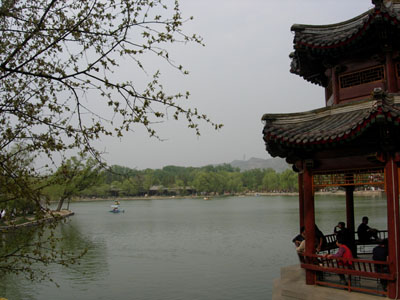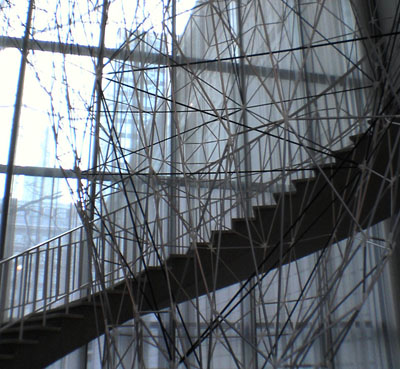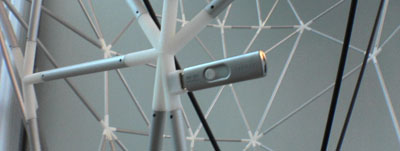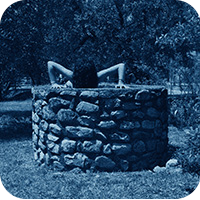Chengde

My colleagues and I made a 4-hour trek to Chengde today. A summer palace of the Qing-era emperors in the mountains northeast of Beijing, Chengde is now a secondary tourist destination. It’s distance from the capital is great enough that you avoid most of the Great Wall tourist fly-bys that clog Badaling. In fact, en route to Chengde you pass some lovely half-ruined sections of the wall (at Simatai, I believe). Problem is, the wall was as interesting as Chengde itself. I wasn’t all that impressed. The grounds of the summer resort verge on dilapidation and the palaces themselves — like those in the Forbidden City — could only be peered into from behind glass. The interiors, also as in Beijing, were dust-draped Imperial still lifes, static and moribund. The rooms felt like tombs to me. Still, the vastness of the resort was sublime and the pagoda-lined lakes lovely. Verdict: not worth 8 hours in the car.
Shang High
Well this is certainly an amazing city. I figured it would be difficult for Shanghai to live up to the hype it has received of late, but I’m unable to really refute things after having spent the better part of the day wandering around the city. Shanghai is comprised of three fairly distinct urban experiences. The newest area, Pudong, is straight out of Blade Runner, all dizzyingly vertical, clad in neon and LCD. The Oriental Pearl TV Tower looks ready for its encounter with the monolith from 2001 while the Jin Mao Tower sports the highest hotel (which I am in) in the world. Looking out my window I stare at three or four skyscraper-topping helipads and half-expect to see early-morning Tai Chi exercises atop them.
The Huangpu river divides Pudong from the main areas of Shanghai. A constant armada of barges and support craft ply the wide river making obvious that commerce is the lifeblood of this city. On foot you cross the river via a futuristic subterranean tunnel that uses four-man pods on electric rails to whisk you through what can only be described as the bastard child of the United Airlines terminal pedway at O’Hare and EPCOT Center. Cheesy, but fun to look at — once.
The Bund, as Europeans called the corniche promenade in the early part of last century, is a striking colonial contrast to the pomo Pudong. You’d almost think you were in pre-war Europe. Actually the opening scene from Indiana Jones and the Temple of Doom comes to mind. Beautiful, yes, but it stares across the river at the gleaming otherworldiness of Pudong and seems anachronistic and mildly pathetic. Architectural evidence of the years between colonialism and China’s recent resurgence is, thankfully, missing — at least here.
Proceeding south into Old Shanghai, you quickly find yourself in a tangled knot of vendor-strewn alleys, meaty odors, and hidden gardens. It is enchanting, actually. A tea house built atop stilts in the middle of a small lake. Rock grottos perfect for forgetting you are in a city of 16 million people. Ponds dense with koi and tourists staring back at them.
First impressions. But clearly the intersection of these diverse urban experiences is the engine (or at least one of the cylinders) powering Shanghai’s stunning vitality.
All Flickrlicious photos here.
See also Dan Washburn’s Shanghai Diaries. Excellent blog.
How to pass a 14 hour plane flight
Watch two stunning movies and spend the rest of the time thinking about them.
On this latest hop over to China — Shanghai, baby! — I took in two of the best movies I’ve seen this year. First was Hero, a Chinese martial arts movie set in pre-unified China. To call it a movie is maybe to overstate the fact that it was distributed on celluloid (or plastic disc). This is a “picture” in the truest sense. The scenes are so visually stunning I would just pause the action and stare. Like walking through a gallery of vivid stop-action animation, but it is all moving of course — and fast. The choreography puts Crouching Tiger to shame and that’s not easy to do.
Then after a too-brief nap in went Saw, a twisted recommendation from my brother. Not scary in the Ring/Grudge way, but ohmygod was it warped. Basic premise: two unlucky strangers wake up in a putrid bathroom, chained to the piping, and told they will die in 6 hours unless one guy kills the other. Depravity ensues. Since I was in the center seat I was constantly looking to my seatmates to make sure they were still sleeping. Some of the scenes in this movie, even seen peripherally, could probably be considered un-neighborly in a crowded airplane. (It was my DVD, not on the plane’s rotation.) Precisely the opposite — but no less enjoyable — than the rich tableaux of Hero.
Projects like menstrual cycles
A friend recently made the observation that no matter how many projects we have running concurrently in our development center they all seem to slide into lock-step and arrive at phases and milestones simultaneously. The analogy she used was that this seemed similar to the way that menstrual cycles of women in close quarters tend to synchronize over time. I find a lot of truth in this and don’t exactly know how to explain it. The extremes don’t seem to apply — if you are in the design phase of one project and launching another you’re obviously too far apart — but projects with only a few months offset do seem to synchronize, somehow. This is most noticeable when you realize that an entire entire category of skilled resource is busy simultaneously. (How come all the information architects are swamped all of the sudden?)
Why does this happen? Could be coincidence, but what if it a kind of macroscopic inability of an organization to truly multi-task? That is, what if there is some underlying tendency which drives teams working in close proximity to maximize productivity by shifting timelines slightly so that they are all in the same phase of a project at once? One benefit would be a kind of lateral development support. (Need help solving this particular design problem? Look at the team next door.) Other than that, though, it seems to me to be a trend fraught with downside: vertical resource shortages, projects completing at the same time (putting large numbers of people on the bench, potentially), and organization-wide single points of failure (if something should happen to prevent some step of the project methodology from being able to proceed.)
Maybe it has to do with pheromones. Thoughts?
Friends who sell things online
Laura Gilligan meticulously creates customized wine charms and other baubles by hand at Cloud Village. Check out the wedding gift detail.
Melissa Pins turns her keen eye for fashion to custom-made dyeable footwear for women at Blue Tux Shoes. Oooh la la!
Matt Wenc creates paintings that warp spacetime ever-so-subtly at mattwenc.com.
The following message was not underwritten by any of the aforementioned merchants. (But I bet they’d like me more if you bought something.)
Remanence
Matt Kirschenbaum has uploaded a really smart essay challenging the common notion of electronic text as impermanent or less stable than the printed word. He argues that the physical trace evidence of supposedly erased data force us to question the prevailing mental models of electronic text and also suggest a range of skills that will be needed of future bibliographers. Can’t wait for his book.
Combine this mode of investigation with the “literary forensics” popularized by people like Donald Foster and the potential for a completely new field of inquiry in new media opens up. The opportunity for a meaningful digital paleography arises precisely because electronic documents are considered so volatile and impermanent; rarely is the effort expended to truly expunge unwanted data. Somewhat boggling (and exciting) to consider what lies undiscovered at the level of the magnetic dipoles.
Act of volition, act of contrition
“Mommy, I accidentally hit Andrew on purpose.” Sobbing, sobbing.
The conflicted emotions of a rambunctious 3½-year-old.
Targetted again
Horrible news from Cairo. A bomb was detonated near the Egyptian Museum today and, in a separate incident, tourists were attacked on a bus elsewhere in the city. This just a few weeks after a popular bazaar was bombed. I fear that the stunning tourism turnaround that Egypt achieved after the 1997 terrorist massacres is officially over.
Infuriating. Especially given the handle that Egyptian authorities seemed to have on security over the last few years.
Tinkertoy iceberg
I finally got a chance to stop by the Art Institute last night to see an installation by Iñigo Manglano-Ovalle. The exhibit is a two-story nylon lattice fabricated from a radar/sonar scan of an actual iceberg off the coast of Newfoundland. Basically he’s taken a structure that is solid for a moment in time (it calves, melts, sinks, reforms), mapped it, broken it down to its wireframe, and created it using rapid prototyping techniques. The result is a complex natural polygon that floats inside a stairwell at the ARTIC.
Much of my work involves scanning artifacts that have not changed in eons in order to most realistically reproduce and preserve them. Which is why Manglano-Ovalle’s process — scanning an ever-changing structure to break it down to its basic geometry and build it back up — is a bit of an intellectual delight.
My friend Craig noticed this little detail. Manglano-Ovalle includes a 512MB memory key in the lattice. A docent noted that all the data from the iceberg scan is contained on that key.
As a bonus we popped down to see the stunning Photo-Respirations exhibit. Tokihiro Sato uses long exposure times, a flashlight (by night), and a sun-reflecting mirror (by day) to create eerie scenes puntucated with will-o’-the-wispy blurs of light. Definitely worth a look.
Thanks for the tip, Matt.
Hizzoner
So I says to Da Mayor, I says, “Give ’em hell in Congress, sir.” He says “I’ll try.” He turns to exit as the plane door opens and we walk down the jet bridge to go our separate ways into D.C.
I wonder how he did?
















